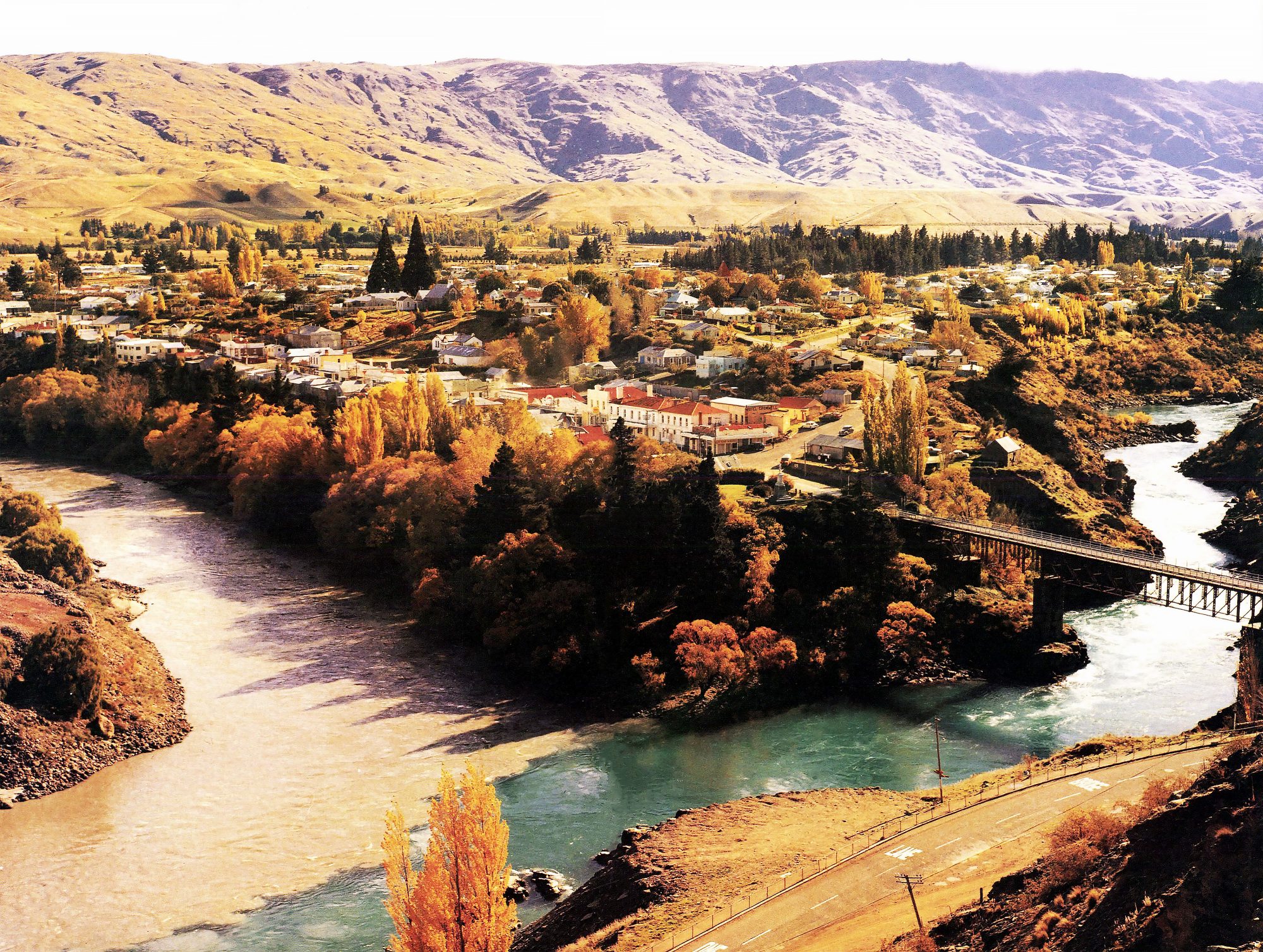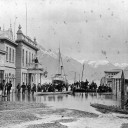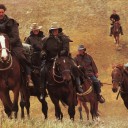
Farewell to the Clutha
The filling of Lake Dunstan to supply water for the Clyde Dam will change the face of the Clutha River forever. Here we portray the Clutha that was, and salute those who fought to save the river monarch.
I paid my last respects to the Cromwell Gorge on the sort of mid-winter Central Otago morning when the air is brittle with cold.
The river, inching imperceptibly up the sides of the gorge, had already drowned most of the remaining trees; the tip of a lone pine protruded mid-stream.
Sturdy apricot trees—last survivors of orchards long gone—shared the sunless east bank with rusty earthmoving equipment. I clambered down a rock-strewn slope to get closer to the water and flushed half a dozen rabbits from the scant vegetation. Soon the swelling river would force them out of their burrows and up to higher ground.
Opposite Cromwell town, excavators were shifting gravel to stabilise the Clutha’s banks, while surveyors in an aluminium dinghy took readings at water level. Behind them the old Cromwell bridge was still high and dry, but cut adrift from the town it once served. I struggled to imagine its brick-red spars submerged, with nine metres of river washing overhead. Turning my back on the river, I found my way to Killala Street, the home of Charlie and Connie Perriam.
Like the rabbits, they had left their home upriver at Lowburn, forced out by a country’s demand for electricity, and a solution that would turn their pasture into grazing for trout and eels. Over lunch of vegetable soup, bacon-and-egg pie, apricots and ice-cream (“North Islanders always ask for apricots!” Connie said with a smile) the Perriams talked of their farm, their life, their 15-year struggle to save the valley.
We looked through old photographs, and later, in the afternoon sunlight, we drove up to Lowburn, and Connie showed me where the farm had been. “That’s where the sheepdog trials are held,” she said, pointing to a steep conical hill, the Sugarloaf, “and that’s where the old hotel used to be. There was a whole community of families here at Lowburn—and they’ve all had to move.”
We crossed a causeway, and Connie looked down at the muddy trickle of the Lowburn Creek. “They say the new lake will fill this inlet, that there’ll be marinas and a motel complex and water scooters …” She fell silent. Looking at today’s barren waste, how could she possibly convey the loss of a hundred years of farm and family life?
Dunedin photographer Lloyd Godman, who chronicled the power of the river in his book The Last River’s Song, echoes their feelings:
Gone! the swirling vortexes, the fly
of spray, the suck and the spit! Gone! the rapids’ roar, the ever‑
changing eddies and the crash
of foam!
Gone! the gentle lap of a river at her bank and violence of her flood! Gone! A River’s Song!
The following day I visited Ray and Nancy Annan in Blenheim. Ray showed me nuggets and flakes he had wrested from the river, and talked of that other gold: the succulent flesh of Cromwell apricots, said by some to be the best the country ever knew. A third generation Clyde orchardist, Ray now grows apples in the more benign Marlborough climate, but the photographs on his walls show that his thoughts still turn to the gravelly hillsides where he hunted rabbits as a boy.
For the Annans and the Perriams, and others like them, time eases, but does not erase, the wrench of letting go family roots. There have been years of pain. New Zealand has gained a dam, but perhaps these pages will also show what is lost when a river gives up its power so that we may have light.
[Chapter-break]
Water was still is, the life-blood of Central Otago. Cromwell was founded on gold and water, and no one grew up near the Clutha without experiencing the river’s power.
I remember, as an eight-year-old, crossing the Clutha on the Lowburn ferry and feeling the current grip the punt and pull it downstream before it was hauled up to the landing. Despite the abundance of water in the river, drinking water was inaccessible and often of dubious quality. An advertisement in an early Cromwell Argus advised travellers coming across to the Bridge Hotel that they must carry their own supply of water from a well on the other side.
Charlie’s forbears came from Devon in the 1860s, at the start of the gold rush. They built a hotel which they called the Welcome Home, and bought good land to farm on the Lowburn river flats. In later years, as many as 16 gold dredges worked the stretch of river between Cromwell and Lowburn—an area known as the Shine Basin—but by the time Charlie and I married and moved to Lowburn in 1945 there was only one gold dredge left on the river above Cromwell.
In the early years timber was almost as precious as gold. Great rafts of sawn timber and logs were floated down the Clutha to Cromwell and Clyde. This was no easy task; often the rafts were broken up by the river’s idiosyncratic currents, and the timber had to be collected and reassembled downstream. After the great flood of 1878 rafting became too hazardous, and was stopped.
The old wooden house in which Charlie and I raised our family was surrounded by wonderful, well-established trees: black and Lombardy poplars, walnuts and willows, some of them 150 feet high. When they started clearing the land for the dam Charlie couldn’t bear to watch those trees being pushed over and buried: 120 years of growth gone in as many seconds—that’s all it took for an excavator to knock one over.
The river wound its way through every part of our lives. In the scorching heat of summer we picked peaches and apricots with the cold blue Clutha flowing silently along side, beckoning us to cool off when the work was done. The river divided itself into a number of channels above Lowburn, and its meandering contours gave us safe areas for swimming. As youngsters, we would also shampoo and rinse our show ponies in the crystal-clear water.
In my day it was common practice to cross the Clutha by boat or punt, but the first settlers used another method: a “chair” or cage suspended on a pulley which ran on a wire rope stretched across the river. Another rope, which passed through pulleys on each bank, allowed the passenger to work his way across.
As bridges were built, chairs fell into disuse, but one at Queensberry, a settlement midway between Cromwell and Luggate, lasted much longer than most. Around the time of the first world war, a schoolteacher I knew used this transport daily for getting to Queensberry School from her home in Tarras. During the 1940s the chair was still in regular use for getting across to dances at Tarras. You can imagine the difficulties, to say nothing of dangers, in those days of long frocks!
A Tarras man leaving for war had planned to cross from the Tarras side and catch the bus at Queensberry, but found to his dismay that the chair was sitting half way across the river, and there was no rope with which to pull it in. Undeterred, the young naval cadet set out hand over hand along the wire rope until he reached the cage, then managed to climb in-40 feet above the swirling waters. The story was often told of the hotel patron who went to sleep in the chair, but, being a creature of habit, not before taking his boots off and dropping them overboard!
River crossings were also made by ferries: wooden punts which were winched across the river. Once, a Luggate punt with a team of six horses on board slipped its moorings and was carried off down the river. The quick-thinking young teamster pushed each horse into the river, then hitched a ride by holding the tail of the last one. Seconds later, the punt was smashed to pieces in the conflicting currents of an area known as Devil’s Nook. Horses and driver all survived.
As a child, I often heard the story of my grandfather, the Luggate punt and politics. One election day he set off with his wife in the horse and buggy to cast his vote at Luggate. Unfortunately, his political views were not shared by the puntman James Smith. When John and Elizabeth Kane arrived at the river, expecting a pleasant crossing, all was quiet—so quiet that they eventually realised their friend Smith would not be ferrying them across the river that day. Not to be outdone, my grandfather travelled twice the distance to cast his vote at Hawea. Oh, for such political fervour today!
For the past few elections Charlie and I have voted whichever way we felt would best save the Clutha. If you fight for something as vital as the life of a river you love, then lose the battle, you feel powerless—utterly devastated. But life goes on, and hopefully in the end you are stronger for the experience.
[Chapter-break]
Hartley and reilly’s discovery of gold in the discovery of gold in the history which has been as swift and turbulent gravels in search of precious “colour”. Then came dredges, their sluicing nozzles biting into the gravel banks and spitting out great islands of tailings which can still be seen today.
Inevitably, as gold became harder to come by, some scoured the river banks with ever-increasing fervour, while others turned to the Clutha’s tributaries and out into the hills. As the population expanded, so did the need for food for hungry miners, and the first farms were started. Sheep and goats did especially well on the native grasses on the hillsides, and rabbits, hares and game birds were introduced both for food and for sport.
My grandfather was one of those pioneers. William Annan saw potential in the gently sloping terraces of the Cromwell Gorge and decided to try fruit growing. The first trees were imported from Australia and planted in 1901. They included citrus, almonds, walnuts, cherries, apricots, apples, pears, peaches, nectarines, quinces and grapes. As an added string to his bow, William, and his wife Margaret, began a dairy farm, supplying milk, cream, butter and cheese to the local people.
The Annans’ orchard was the first of 12 established in the Cromwell Gorge. The soil proved to be ideally suited to apricot culture, and the frost-free spring climate spared young blossoms and fruitlets from the damage which is sustained elsewhere in Central Otago.
I was part of the third generation of Annans to grow up in the gorge, this 20-kilometre stretch of river between Cromwell and Clyde which has particular significance not only in my life, but now also for the whole country. The first and most insistent lesson we learned was a simple one: “Don’t ever go near the river!” Unlike the more docile sections upriver past Cromwell, the gorge part of the Clutha was fast and potentially fatal. The lesson was driven home to me one day in 1956 when the Clutha was in flood. Our school class was taken to the Clyde bridge to watch the torrent roaring a few feet under the bridge deck as it hurtled down to wreak havoc on Balclutha and the river delta. We watched as willow trees the size of houses were tossed around like toy boats. I was left in no doubt as to the power of that river.
As we children grew older and became confident swimmers, the warnings grew fewer. Fishing, gold-panning and general fossicking along the river banks became part of our lives.
When you see “colour” in your pan after half an hour of painstaking washing, it’s easy to understand the gold fever that possessed the prospectors of the past. Before long you graduate to more sophisticated gear, you become more knowledgeable about the good spots, and passion for the yellow metal becomes more intense. But to my knowledge no one has made a fortune out of the river’s treasure in modern times. One couple who worked in our orchard for a season recovered enough gold to have two wedding rings made, but not their fortunes.
School did its part to teach me the ways of the river, and I have never forgotten a poem written about the time the first dam was being built at Roxburgh:
When you see the mighty Clutha
Rolling eastward to the sea
Do you wonder why it hurries?
Well, it’s struggling to be free
For that puny mortal man
Has robbed its liberty:
It has fallen from a monarch to a slave.
During teenage years I loved nothing better than to take to the slopes above the gorge with a rifle and a backpack. Rabbits were abundant, and it didn’t take long before I had all the good shooting sites sorted out, and knew all the ridges and gullies by name.
I developed a keen interest in the history of the gorge, particularly of the miners who lived in stone huts and caves in the hills and on the river banks. These tough characters endured 30-degree heat in summer and below-zero frosts in winter in the most basic of shelters. Because the climate was so dry there were very few trees to cut down for firewood, and the only local building material was stone and mud. Many miners lived only in a calico tent. To keep warm on a winter’s night they would put a stone in the fire, rake it out when it was hot, wrap it in a blanket and take it to bed with them.
During these years the gorge was changing. Rabbits had eaten out most of the native grass, making way for scab weed on the dry, sunny faces and sweet briar on the dark faces, and in some areas wild thyme took over whole hillsides. For many of the locals the briar berries and thyme provided an income: thyme was processed by a herb factory in Clyde, and briar berries ended up in Rose Hip Syrup, a popular infant’s drink in those days.
As a keen hunter, the plentiful game suited me fine. I could shoot rabbits and goats all year round, and in the game bird season there were Californian quail and Himalayan chuckor to be had. The latter live around the snow line and fly at amazing speeds around the hills. After each flight they invariably walk uphill, so the trick was to keep above them. Sometimes I would wait for what seemed like hours, listening for their calls, and the thrill of sitting in the winter sunshine high in the hills and looking down on the gorge with the river deep in its belly was pleasure enough for me.
Not only did the river have a magnetic fascination, luring me to spend hours just watching and listening to its eddying flow, but also an awesome physical power, as illustrated by the tragic loss of a petrol tanker driver who was drowned when his vehicle went into the river off the road above Cromwell. The tanker was located the following day some 60 kilometres downstream—nearly at Roxburgh.
The big minus in gorge life was undoubtedly winter. Because of the high hills we didn’t see a lot of sun—in fact, in June the sun rose at a quarter past ten and set at quarter to three: just four and a quarter hours of sunshine per day. With frosts of four to six degrees, that is something I do not miss these days.
Lake Dunstan will blot out the legacy of 80 years of work and three generations of Annans. All that will be left is a stand of trees to mark the site: a couple of black poplars and some Lombardies. The lake will no doubt be an asset to all who live in the area, but it will not erase in my mind the history that has been hewn from the rocks and the river of my gorge.















